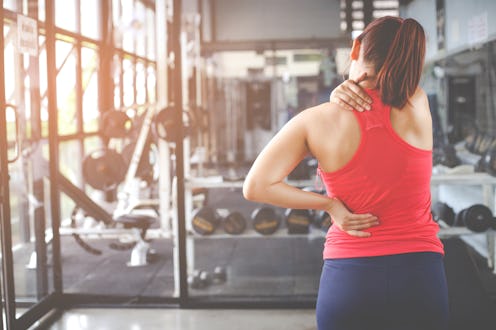All Levels Welcome
3 People Explain Why They Won’t Go Back To The Gym Post-COVID
"Chronic pain and gyms do not mix well."

This piece is part of Bustle’s All Levels Welcome, a column about making fitness culture as accessible and inclusive as possible.
As states across the country begin re-opening their gyms, many fitness enthusiasts are hesitant to return to their nearest weight room. A lot of people are waiting to see if infection rates spike as businesses open their doors again, but others say that even after COVID, they may not return to the gym at all.
"If I'm going to work out at all, the gym is the worst place for me to lift," says an anonymous 27-year-old who lives with chronic pain. The setup of most fitness facilities just isn't designed for the rest periods and movements they need. "I have some dumbbells at home, because no one will give me weird looks for the modifications I have to do. Working out at home, I don't feel stupid, weak, or lazy for moving as slowly and carefully as I need to."
They tell Bustle that gyms closing during COVID has been a bit of a positive for them. "Working out at home is the new mainstream norm," they say. "With more fitness classes online, I can stick to what works for me and take as many breaks as necessary — and no one can judge me for it because I'm in my living room, and so is everyone else." They hope that online fitness will be here to stay even after COVID so they won't feel so locked out of physical fitness spaces.
Even online, mainstream fitness culture often emphasizes "no pain, no gain" attitudes that can do more harm than good. "Chronic pain and gyms do not mix well," says Spikey, age 33. Even though he was active in his local climbing gym as a teenager, his experience with chronic pain means that gyms opening back up are of no consequence to him. The risk of getting COVID at the gym isn't the only downside to fitness centers — it's also about what's generally healthiest for his body. "I would only be in even more pain if I went to work out," he says, so he doesn't.
You collapse on the couch, completely drained of all energy even though the only thing you've done today is being at the gym for under an hour.
Working out at home can have safety benefits that the gym lacks, the anonymous 27-year-old tells Bustle. "If my movements trigger a flareup, I can stop immediately without having to pack my stuff and navigate through the gym and all the way back home. And, when I exercise at home, I don't feel pressured to keep working out because of how other people looked at me when I would leave a few minutes after I got to the gym."
Audrey, 33, says that working out with chronic pain can be extra difficult when gym membership dues come into play. While many folks have been upset over lost fitness fees during COVID-related gym closures, losing money to the gym is a common reality for folks who live with chronic illness. "Whenever I need another surgery or just have a really bad flareup, there goes a month or more's worth of lost gym money," she says. "And even outside of the pandemic, you can't afford to spend extra money when you're surviving on disability benefits."
More often than not, Audrey says, gyms just don't have policies that allow easy freezes on your membership. But even when gyms are financially accessible, physically getting on the floor isn't always possible — and not just during pandemic-related temperature checks and mask requirements. "You'd be surprised how many gyms have stairs leading to their main areas," Audrey tells Bustle. "Even on days I can navigate stairs, it reminds me that the gym wasn't made for me. In a lot of ways, it was made to keep me out."
In addition to physical barriers, gyms can also be overstimulating sensory spaces. Loud and sudden iron clanging, blaring music, and questionable smells might feel like a second home for some, but for others, it can create pretty painful sensory overload. "When you are already in pain and so tired, all those sensory inputs hit so much harder," says Spikey. "That flickering light that was just a minor nuisance is now so pervasive that you can't focus on counting reps ... Then when you get home, you have a massive headache, achy eyes, ringing ears, and you collapse on the couch, completely drained of all energy even though the only thing you've done today is being at the gym for under an hour."
Finding gyms that are friendly to neurodiverse folks and disabled fitness communities is of the utmost importance, Audrey says. "Respecting your own body, not some white, cis, able-bodied Instagram standards, should be at the center of fitness," she tells Bustle. "Creating community with people who get it helps so much. But until the fitness industry at large embraces my chronically ill body, I'll stay healthier by skipping the gym."